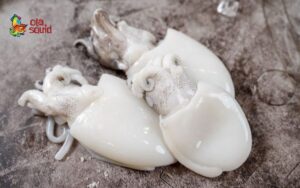Dried squid – a gift from the sea with a distinctively savory and delicious flavor, not only an attractive specialty but also a culinary memory for generations. However, to preserve the sweet, chewy texture and nutrients in every shred of squid, proper preservation of dried squid is essential. In the following article, let Ola Squid guide you through simple yet highly effective methods to protect this “essence of the sea”!
What are the health benefits of eating dried squid?
Before delving into how to preserve dried squid, let’s review the nutritional values this seafood offers. Dried squid is not only appealing for its savory flavor but also a precious source of nutrients from the ocean. Here are the outstanding benefits dried squid brings to human health.
Supplementing essential protein and minerals
Dried squid contains a high protein content, playing a crucial role in building and maintaining muscle mass. Additionally, this seafood is rich in minerals such as zinc, calcium, and iron, which help boost the immune system and support strong bones. Incorporating dried squid into your daily diet is an effective way to maintain stable health.
Good for cardiovascular and nervous systems
Vitamin B12 in dried squid helps stimulate red blood cell production, improve blood circulation, and reduce the risk of anemia. Amino acids in squid are also beneficial for the nervous system, supporting brain function and reducing mental stress. This is a suitable dish for the elderly, office workers, or those who engage in intellectual work.

Supports weight management and cholesterol control
Dried squid contains virtually no saturated fat, making it ideal for those on a diet or managing cholesterol levels. Compared to processed foods, dried squid is a healthy choice, does not cause weight gain, and is safe for cardiovascular health. A small portion of dried squid can provide energy without worrying about excess fat.
Enhances appetite and replenishes energy
Just a few fragrant grilled squid slices are enough to awaken the taste buds and make meals more appealing. With high protein content and easily absorbed micronutrients, dried squid is a quick source of energy for the body to function throughout the day. It’s an ideal snack for busy people, those who are active, or need extra stamina for work.
Why is it important to preserve dried squid correctly?
Dried squid is a food product that has undergone drying or sun-drying processes to remove most of its moisture, thus extending its shelf life. However, being “dry” does not mean “imperishable.” Under unsuitable storage conditions such as damp places, direct sunlight, or polluted air, dried squid can still be easily contaminated by bacteria, mold, insects, or undergo oxidation.
In such cases, not only the delicious flavor and natural chewiness of the squid are affected, but also the nutritional components like protein and minerals can decompose or become denatured. Even worse, moldy dried squid can produce aflatoxins – a substance harmful to the liver and immune system if consumed long-term. Additionally, signs of spoilage such as unusual odors, abnormal colors, or a slimy surface will significantly reduce the product’s usability.

Therefore, understanding how to preserve dried squid correctly not only helps you maintain the unique flavor and deliciousness of this dish but also ensures food safety and protects the health of your entire family. A few small, correct steps will help you preserve the “essence of the sea” for a long time without worrying about quality.
Smart ways to preserve dried squid
Here are popular and effective methods for preserving dried squid, helping you extend its shelf life and maintain its quality as if it were freshly bought.
How to store in the refrigerator
The refrigerator is an ideal place to keep dried squid fresh for a long time. Simply place the squid in a zip-top bag or an airtight container and store it in the fridge compartment (between 1-4°C). If you want to store it for several months, it’s best to put the squid in the freezer and vacuum seal it to prevent freezer burn, thus preserving its flavor.
How to store at room temperature (without refrigeration)
If refrigeration is not an option, you can still store dried squid at room temperature by:
- Wrapping the squid tightly in clean newspaper or a sealed zip-top bag.
- Storing it in a dry, well-ventilated place, away from sunlight and humidity.
- You can add desiccant packets to the squid’s storage bag.
However, this method should only be used for a short period (under 1 month) to ensure food safety.

How to preserve using vacuum sealing and airtight containers
This is the optimal method to prevent dried squid from oxidizing or molding. Use a vacuum sealer to remove air, then store in an airtight container. With this method, squid can retain its deliciousness and color for up to 6-12 months.
How to preserve dried squid when traveling
When taking dried squid on trips, business travels, or sending it to relatives far away, you need to pay special attention to packaging and preservation. The travel environment often has unstable temperatures and humidity, which can degrade the squid’s quality if not prepared properly. Here are some effective preservation tips:
- Use zip-top bags or vacuum-sealed bags: Ensure the squid does not come into contact with air, helping to maintain its dryness and natural flavor.
- Include desiccant packets: Add 1-2 food-grade desiccant packets to prevent the squid from becoming soggy or moldy due to humidity changes during transport.
- Avoid direct sunlight: Do not expose the squid to sunlight or place it near high-temperature areas like car trunks, heaters, etc., as this can cause the squid to release oil and lose its flavor.
- Prioritize styrofoam boxes or insulated bags: For long journeys or hot weather, a styrofoam box will help maintain a stable temperature and protect the squid better.
- Do not open the packaging frequently: Limit opening the bag unless necessary, as air entering will quickly reduce quality.
With these simple steps, you can confidently take dried squid with you without worrying about losing its flavor or spoilage along the way.
Common mistakes when preserving dried squid
Dried squid is a durable food product, but it is still very “sensitive” to its surroundings. Many people, due to complacency or lack of knowledge, make seemingly small mistakes that cause the squid to deteriorate quickly, sometimes rendering it unusable. Here are common mistakes you should avoid:
- Storing squid in damp places or near cooking areas, causing it to absorb moisture, become moldy, and lose its aroma.
- Not sealing the packaging, allowing squid to be directly exposed to air and insects, leading to oxidation and spoilage.
- Storing squid for too long without regular checks, missing signs of mold, discoloration, or strange odors.
- Using thin plastic bags that are permeable to air and moisture, failing to protect the squid from humid environments.

Tips for selecting high-quality dried squid initially
To preserve dried squid effectively, you first need to choose fresh, high-quality squid from the start. Here are the characteristics of good, worthy dried squid to buy:
- Natural color: The squid has a white-pink or light pink color, not too red, not dark or blotchy.
- White powder on the back: It has a thin, even layer of white powder, which is natural salt crystallization after drying, not a chemical.
See now: Is dried squid with white powder delicious?
- Thick, dry body: Good squid is usually thick, evenly dried, without any slimy fluid or unpleasant odor.
- No strange smell: A light, natural aroma, not fishy, not chemical or moldy.
- Firm to the touch: The squid is neither too soft nor too hard, with slight elasticity when bent.
Recommendation: It is advisable to buy squid from reputable seafood stores with clear packaging and expiration dates to ensure food safety. Ola Squid is currently one of the trusted addresses for many customers, specializing in high-quality dried squid with clear origin, standardized packaging, and always ensuring freshness. You can explore and experience the difference in every strand of squid!
See now: How to choose delicious, safe dried squid that only insiders know!
Regular inspection and preservation schedule
Even if you have applied the correct dried squid preservation methods, regular inspection is still crucial. This helps you detect signs of spoilage early, allowing for timely action, preventing waste, and preserving the delicious flavor.
- Inspect every 2-3 weeks: Especially for squid stored at room temperature, you should open the container or bag to check the squid’s condition, detecting any signs of mold or strange odors early. This helps adjust the storage environment or take timely action, preventing more severe spoilage.
- Handling damp squid: If the squid shows signs of dampness or becomes mushy, you should lightly sun-dry or re-dry it at a low temperature to dry it out again. Then, seal it tightly and store it in a dry, cool place to prevent recurrence.
- Note for frozen squid: Avoid thawing multiple times, as each thawing cycle will cause loss of natural flavor, reduced sweetness, and make the squid meat easily mushy. It is best to divide the squid into small portions before freezing for gradual use, only thawing what is needed.
Maintaining a regular inspection and preservation schedule not only helps preserve the quality of the squid but also ensures food safety for consumers. Remember this to keep your squid as fresh as when you first bought it!

Learn more: Discover the process of producing delicious, standard dried squid
FAQ – Frequently Asked Questions
Preserving dried squid might seem simple, but not everyone knows how to handle issues when they arise. The following Q&A section will help you clarify all your doubts and keep your batch of squid fresh and safe.
How to handle moldy dried squid
During storage, if you notice slight signs of mold on dried squid but no strange odor, you can follow these steps to continue using it:
- Use a clean cloth or dry paper to gently wipe off the moldy parts on the squid’s surface.
- Sun-dry the squid in strong sunlight for 1-2 hours to re-dry and kill any remaining bacteria and mold. If there’s no sun, you can dry the squid at a low temperature (50-60°C) for a few dozen minutes.
- After processing, place the squid in a vacuum-sealed bag or airtight container, and store in a dry, cool place for continued preservation.
Note: In cases where the squid has turned black, has a strange foul odor, or is slimy, do not consume it as the squid has been deeply contaminated and can be harmful to your health.
How to distinguish real from fake dried squid
To help you easily identify and avoid buying fake, low-quality dried squid, let’s compare real and fake dried squid in the table below:
| Criteria | Real Dried Squid | Fake Dried Squid |
| Shape | Natural, squid body is soft and chewy. | Unnatural color, not authentic. |
| Meat texture | Has clear meat fibers. | Lacks clear meat fibers. |
| Aroma when grilled | Has a light, characteristic sea aroma. | No aroma, may have a chemical smell. |
| Feel when touched | Soft, chewy, slightly elastic. | Hard, brittle, or uneven fibers. |
Small tip: To ensure you buy real, delicious, and safe dried squid, choose Ola Squid – a reputable address with genuine products that have undergone clear quality inspection.
Dried squid is a precious gift from the sea, but it is also a product that can spoil easily if not preserved correctly. Hopefully, through this article, you have learned effective methods for preserving dried squid, thereby retaining the delicious flavor and nutritional value in every strand. And to feel more confident when choosing quality dried squid, come to Ola Squid – a place that offers clean, delicious dried squid products, rigorously inspected, allowing you to preserve it easily and fully enjoy the taste of the sea right at home. Order now to experience the difference!


 Tiếng Việt
Tiếng Việt ไทย
ไทย




